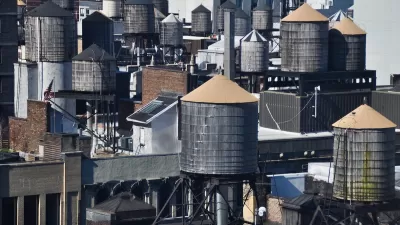Regulation and incentivization helped cities in the Western United States keep water usage and population growth on opposite trend lines.

Despite increasing populations, numerous western U.S. cities have reduced water use in the past 20 years, according to a new study. Melissa Sevigny interviewed the study's lead author Brian Richter to learn more about "how simple water conservation measures could be a cost-effective way to combat shortages in the Colorado River Basin."
Richter explains that of the 20 western cities, two-thirds saw water usage drop. "What we found across the board in the western Cities that we surveyed—we looked at 20 different cities—we found their average rate of growth from 2000 to 2015 was about 21 percent, yet their average rate of reduction in their water use was 19 percent," describes Richter in the interview.
Financial disincentives for landscaping irrigation has contributed significantly to the decline in water use, according to the article. "The other big part of the story was indoors, on toilets," says Richter. Richter points to the Federal Energy Policy Act of 1992, which reduced water use by mandating that new toilets sold in the United States would be highly energy efficient. "Overnight, the new toilets being sold were using half of the water that they did previously," Richter notes.
According to Richter, the precedent that has been set for water conservation so far still leaves a lot of room for improvement.
FULL STORY: Study: Water Use Dropping In Western Cities Even While Population Grows

Planetizen Federal Action Tracker
A weekly monitor of how Trump’s orders and actions are impacting planners and planning in America.

San Francisco's School District Spent $105M To Build Affordable Housing for Teachers — And That's Just the Beginning
SFUSD joins a growing list of school districts using their land holdings to address housing affordability challenges faced by their own employees.

The Tiny, Adorable $7,000 Car Turning Japan Onto EVs
The single seat Mibot charges from a regular plug as quickly as an iPad, and is about half the price of an average EV.

As Trump Phases Out FEMA, Is It Time to Flee the Floodplains?
With less federal funding available for disaster relief efforts, the need to relocate at-risk communities is more urgent than ever.

With Protected Lanes, 460% More People Commute by Bike
For those needing more ammo, more data proving what we already knew is here.

In More Metros Than You’d Think, Suburbs are Now More Expensive Than the City
If you're moving to the burbs to save on square footage, data shows you should think again.
Urban Design for Planners 1: Software Tools
This six-course series explores essential urban design concepts using open source software and equips planners with the tools they need to participate fully in the urban design process.
Planning for Universal Design
Learn the tools for implementing Universal Design in planning regulations.
Smith Gee Studio
City of Charlotte
City of Camden Redevelopment Agency
City of Astoria
Transportation Research & Education Center (TREC) at Portland State University
US High Speed Rail Association
City of Camden Redevelopment Agency
Municipality of Princeton (NJ)





























